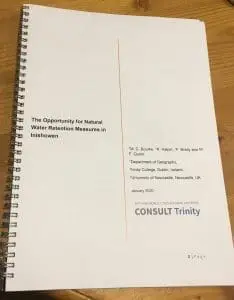Community discuss natural flood management measures
February 2020 – On Friday 14th February, the Inishowen Rivers Trust invited the community to hear more about their research into Natural Water Retention Measures (NWRM) and discuss the opportunities for delivering these in Inishowen. The meeting held in Colgan Hall was attended by a diverse range of interested parties from across the peninsula. The study, produced by the IRT in collaboration with Trinity College Dublin and funded by the OPW, was launched by OPW representative Conor Galvin, who commended the Trust and the community on bringing this research forward.
The report, entitled ‘The Opportunities for Natural Water Retention Measures in Inishowen’, recommended nature-based solutions that would be suitable to implement in Inishowen such as offline ponds, bunds, leaky dams and soakaways. The main author of the report, Prof Mary Bourke, described the types of measures and how they worked, while her colleague Dr. Paul Quinn from the University of Newcastle, elaborated on his experience of implementing measures in the UK. Such measures have been shown to reduce flooding in smaller catchments such as Belford in north east England. Prof Bourke said, “Our climate has already changed. Floods will happen and doing nothing is not an option. The solutions we are suggesting in our report are simple, sustainable and proven elsewhere.” Dr. Quinn added, “These solutions essentially ‘slow the flow’ and increase the length of time it takes the water to travel through the system, thus reducing the impact of the flood downstream.“
Following the presentation, the community engaged in a wide-ranging discussion sharing stories on the fear of living with floods, issues with obtaining insurance, a lack of engagement with the agencies, farmer and landowner engagement, and the possible opportunities that flood management can bring. Under the OPW and DCC, flood relief schemes will be progressing in parts of Inishowen but these can take a number of years to implement. NWR measures are more cost effective, quicker to install and can complement hard engineering techniques.
What happens next is up to the community. “If the community approves the idea, we can start this summer.” said IRT director Dr. Trish Murphy. “The IRT can apply for funding to implement solutions but we all need to work together on this. As a first step, there would be detailed consultation with individual landowners.” Rosemary McCloskey, another director of the Trust added, “I work in the Frome catchment in Stroud, which has a long history of flooding. We work with landowners to find the best solutions for everyone. They understand their property and we provide the latest science and techniques. It’s a learning process but one that is paying off for the community there.” Dr. Quinn stressed that the solutions are small and need to be upstream in the headwaters of the catchment, not where the flooding occurs. As one member of the audience noted, “Prevention is better than cure”.
Many thanks to everyone who attended the event and to the panel of experts for sharing their knowledge and expertise. If you want to learn more about this research by the Trust, you can download an IRT Opportunities for NWRM – Executive Summary of the Report here. If you would like to get involved and be part of the solution, you can register your interest contacting us on 087 647 8183.



